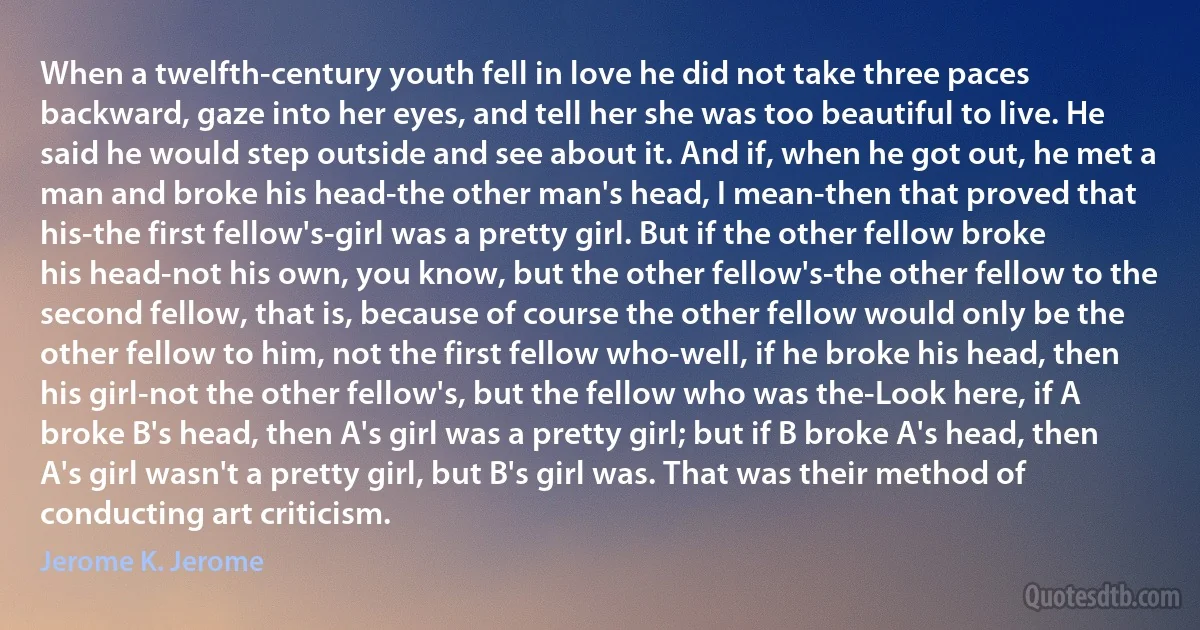
When a twelfth-century youth fell in love he did not take three paces backward, gaze into her eyes, and tell her she was too beautiful to live. He said he would step outside and see about it. And if, when he got out, he met a man and broke his head-the other man's head, I mean-then that proved that his-the first fellow's-girl was a pretty girl. But if the other fellow broke his head-not his own, you know, but the other fellow's-the other fellow to the second fellow, that is, because of course the other fellow would only be the other fellow to him, not the first fellow who-well, if he broke his head, then his girl-not the other fellow's, but the fellow who was the-Look here, if A broke B's head, then A's girl was a pretty girl; but if B broke A's head, then A's girl wasn't a pretty girl, but B's girl was. That was their method of conducting art criticism.
Jerome K. JeromeRelated topics
art beautiful broke conducting course criticism fell fellow girl head live love man met outside pretty say second see step take tell three youth eyesRelated quotes
Repression, Sir is a habit that grows. I am told it is like making love-it is always easier the second time! The first time there may be pangs of conscience, a sense of guilt. But once embarked on this course with constant repetition you get more and more brazen in the attack. All you have to do is to dissolve organizations and societies and banish and detain the key political workers in these societies. Then miraculously everything is tranquil on the surface. Then an intimidated press and the government-controlled radio together can regularly sing your praises, and slowly and steadily the people are made to forget the evil things that have already been done, or if these things are referred to again they're conveniently distorted and distorted with impunity, because there will be no opposition to contradict.

Lee Kuan Yew
The little guy's face was a bloody mess. Between the puffballs of blue-black flesh that used to be eyelids, the dull gleam of shock-deadened pupils watched Dilwick uncomprehendingly. His lips were swollen things of lacerated skin, with slow trickles of blood making crooked paths from the corners of his mouth through the stubble of a beard to his chin, dripping onto a stained shirt.
Dilwick stood just outside the glare of the lamp, dangling like the Sword of Damocles over the guy's head. He was sweating too. His shirt clung to the meaty expanse of his huge neck. He pushed his beefy hand further into the leather glove and swung. The solid smack of his open hand on the little guy's jaw was nasty. His chair went over backward and his head cracked against the concrete floor of the room like a ripe melon. Dilwick put his hands on his hips and glared down at the caricature that once was human.

Mickey Spillane
As everybody who met him noted, Krajisnik had only one long and extraordinarily brushy eyebrow, which spanned his forehead, creating what looked like a permanent dark cloud over his deep-set eyes. Although Krajisnik had not been indicted by the War Crimes Tribunal - and could therefore participate in Dayton - it was hard to distinguish his views from those of his close friend Radovan Karadzic. Milosevic had often said that Krajisnik was "more difficult" than Karadzic, but we had little basis on which to make an indipendent judgment. (...) He and Izetbegovic knew each other well, from lengthy meetings in the Bosnian Assembly before the war. Krajisnik owned a five-hectare farm on the edge of Sarajevo, in an area that would probably revet to the Muslims in any settlement, and we often made bitter jokes that the war was really over "Krajisnik's five hectares."

Richard Holbrooke
Within a decade, maybe two or three, Christians will come around to treating gays no differently than they now treat other groups whom they previously persecuted - women, Jews, blacks - but not because of some new interpretation of a biblical passage, or because of a new revelation from God. These changes will come about the same way that they always do: by the oppressed minority fighting for the right to be treated equally, and by a few enlightened members of the oppressing majority supporting their cause. Then what will happen is that Christians will take credit for the civil liberation of gays, dig through the historical record and find a few Christian bloggers or preachers who had the courage and the character to stand up for Gay rights when their fellow Christians would not, and then cite those as evidence that were it not for Christianity gays would not be equal.

Michael Shermer
At first we got along very well. Esipova even boasted outside the class that she had pupils who wrote sonatas (I completed Sonata, Op. 1, and played it to Esipova, who took it home and inserted pedaling). But before long trouble began. Esipova's method of teaching was to try to fit everyone into a standard pattern. True, it was a very elaborate pattern, and if the pupil's temperament coincided with her own, the results were admirable. But if the pupil happened to be of an independent cast of mind Esipova would do her best to suppress his individuality instead of helping to develop it. Moreover, I had great difficulty in ridding myself of careless playing, and the Mozart, Schubert and Chopin which she insisted on were somehow not in my line. At that period I was too preoccupied with the search for a new harmonic idiom to understand how anyone could care for the simple harmonies of Mozart.

Anna Yesipova
